FILO is a winsome gaff-rigged sailing dinghy reminiscent of catboats first seen along the New England coast in the 1840s. At 11′ LOA, with a 5’0″ beam and 8″ draft (daggerboard up), this beamy daysailer—designed for protected waters—combines characteristics of a Cape Cod cat with elegant features of the classic Whitehall. She is charming and graceful under sail.
FILO’s saga began when her owner, Tom Darnton, replaced his old, leaky waders with a new pair, seeking comfort during the annual spring ritual to install the dock at the family cottage on Lake Charlevoix in northwestern (lower) Michigan. Snug against the elements, he stood hip deep in frigid water, as a zephyr skimmed the surface under azure skies—a beautiful day to sail. Gazing across Oyster Bay, he imagined himself tacking a small wooden daysailer with traditional lines, a boat that he could put on a cart, roll to the water’s edge, launch, and sail alone.
After considering various designs, Darnton was smitten with designer Charles Wittholz’s 11′ catboat dinghy, with its round bottom, nearly wineglass transom, sweeping sheer, gaff rig, eye-catching details, and versatility under sail, or, unrigged, under oars or outfitted with a small out-board engine. Relatively large for a dinghy, with fine lines despite a broad beam, she is a throwback to a simpler time in America. She is ideal for Lake Charlevoix, with its rich maritime heritage. Over a century earlier, the lake teemed with wooden schooners and steamers carrying passengers and freight along the shore.
Darnton commissioned the Great Lakes Boat Building School (GLBBS) in Cedarville, Michigan, to build FILO (meaning first in, last out). Wittholz had drawn his well-detailed plans with an eye toward the home-based builder, starting with a cold-molded hull, which has no frames, thus eliminating steam-bending. The first layer is 1⁄4″ western red cedar running fore-and-aft. That layer is covered with two diagonal layers (set at 90 degrees to each other) in 1⁄16″ African mahogany. This monocoque hull requires only minimal maintenance and weighs less than a comparable one built in either solid wood or fiberglass. FILO features a constellation of woods, including white oak for her keel, tiller, and its extension, sapele for her inwales and rubrails, Douglas-fir for the rudder, and Douglas-fir marine plywood for the stem. Okoume marine plywood was used to build the foredeck, thwarts, daggerboard, and daggerboard trunk. Her spars are in Sitka spruce, and floorboards and oars are Alaska yellow cedar.
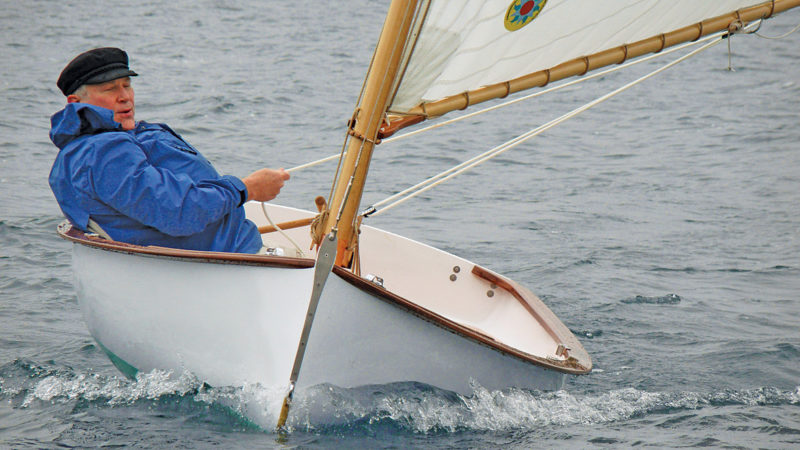 George D. Jepson
George D. JepsonWhether sailing in a stiff breeze or light airs, the robust little cat is lively on a reach.
This project requires intermediate to advanced skills; even Patrick Mahon, lead instructor at the GLBBS, found bringing together the wineglass transom and narrow skeg at the stern to be a bit of a brain-teaser. But once the hull was completed, he found building and installing the daggerboard and trunk, foredeck, thwarts, trim, and spars to be straightforward. The stem is composed of three laminated layers of 3⁄4″ Douglas-fir plywood. The foil-shaped daggerboard and barn-door rudder (made of okoume plywood) are sheathed in epoxy and fiberglass cloth. Wittholz only suggested lofting as an option, but those who have built the boat strongly recommended it to enhance interpretation of the plans and better grasp some of its more complex details.
The dinghy’s plans offer various options for builders and owners. Darnton chose a daggerboard—Wittholz’s original specification—over a centerboard in order to conserve cockpit space. The designer added a pivoting centerboard option in his plans for those who prefer that alternative. Darnton ordered a second tiller with an extension for singlehanding FILO. The gaff rig was chosen over the optional marconi rig for its appearance from bygone days. Finally, the sternsheets stretch forward to the ’midship thwart, a deviation from Wittholz’s plan, which offers a bit more seating for the helmsman.
FILO is finished with a traditional livery; the top-sides and cockpit are painted white, while the bottom from the waterline down is sea-mist green. The stern-sheets and thwarts are buff colored. Standard marine enamels were used, allowing Darnton to do touch-ups in his garage. Rubrails, thwarts, foredeck, and spars are finished bright, clear-coated with epoxy and varnish. The floorboards are unfinished. The dinghy was fitted out with off-the-shelf stainless-steel hardware, with the exception of the stem fitting that secures the forestay, which was custom fabricated in stainless steel.
FILO’s custom, full-battened white Dacron mainsail was cut and sewn at Sperry Sails in Marion, Massachusetts. This is a slight departure from Wittholz’s traditional design, which did not include battens. Darnton chose the Sperry sail based on an article he read in WoodenBoat about the gaff-rigged daysailer-weekender WAVE, designed by Nat Benjamin (see WB No. 214). Full battens facilitate balanced load distribution and shape the sail, while a single reefpoint allows shortening it in a blow.
Raising or breaking down FILO’s rig takes only a few minutes. The sail is laced to the boom, gaff, and mast, and is raised and lowered with a halyard. The mast, which passes through the foredeck and is stepped on the keel, is supported with a 1⁄8″ stainless wire forestay. Darnton leaves the rig in place and keeps the boat on a mooring in front of the cottage, when the family is in residence. A custom canvas boom tent keeps the sail and cockpit dry.
The versatile 11′ dinghy is an ideal cottage craft that can be sailed or rowed from the beach or a mooring. She is also well suited as a tender for a power yacht or deepwater sailboat. She will tow easily behind a larger boat in relatively calm conditions but may bounce around quite a bit in a chop. Wittholz originally conceived the dinghy as a tender for a power or sailing yacht, hanging from davits when not in use.
Weighing just 150 lbs, FILO can be easily towed on a small trailer and launched from a ramp or stored on shore and floated off a hand-pulled dolly. Two or three people can also carry her to the water’s edge. She is ideally suited for waterfront cottage life or for trailering to favorite destinations.
Under a slate sky, a stiff northerly breeze is blowing down Oyster Bay. It’s mid-June, but this is northern Michigan, where the weather can bring a chill beneath storm clouds, followed within hours by cerulean skies and warm sunshine. The wind is whipping near 15 mph, with higher gusts, creating a chop on the bay. This is the type of weather that will put FILO through her paces.
Darnton dry-sails FILO off a dolly parked on the shingle at the base of a cedar-covered hill below the cottage. Already rigged, she is ready to sail within minutes once he removes the cover and rolls the dolly through shallow water to a mooring buoy. Darnton releases the painter as he raises the sail. She catches the breeze heeling as she cuts across to the opposite shore on a reach. Occasional puffs put her rail in the water, exposing her green undersides.
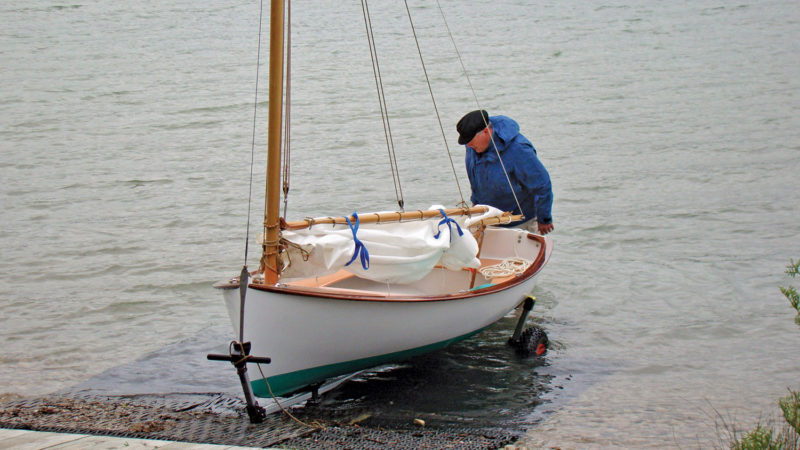 George D. Jepson
George D. JepsonThough traditional in appearance, FILO’s cold-molded hull makes her easy to trailer and very easy to maintain.
FILO’s fine entry slices neatly through the waves. She makes broad turns while tacking and likes to go to windward. Sailing singlehanded, the helmsman’s optimal position is just abaft the ’midship thwart to achieve fore-and-aft trim. Sitting too far forward results in the bow pushing water, rather than sailing through it.
Although she has a relatively high free-board and is reasonably stable for a sailing dinghy, FILO is probably not a boat for absolute novices; she will not tolerate a lot of shenanigans under sail. An unexpected knockdown or pushing the envelope in a robust breeze can capsize her. Her intended capacity is four passengers, but I recommend two for comfortable sailing. She is a delight to sail and has little weather helm.
By early evening, the skies are blue as the sun dips toward the horizon over nearby Lake Michigan. A light sea breeze propels us back and forth on the bay, as we take turns at the helm. The only sound is the peaceful gurgle of water against the hull. This comely cat will make her mark for years to come on Lake Charlevoix, crisscrossing the wakes of ghosts from another era, when canvas sails puffed full and steamers’ stacks trailed ribbons of smoke. ![]()
—
Plans for the Wittholz 11′ Dinghy can be ordered from The WoodenBoat Store.
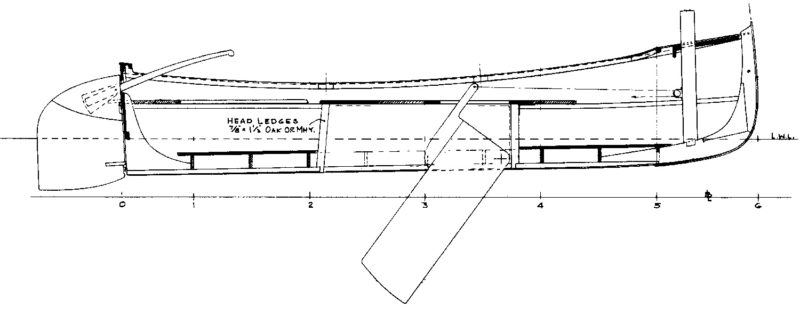
While borrowing her narrow entry, raised transom, and sweeping sheer from the classic Whitehall, the Wittholz dinghy remains a true catboat with her broad beam, tum-blehome stem, and barn-door rudder. FILO’s owner chose the gaff rig to complete the catboat look.
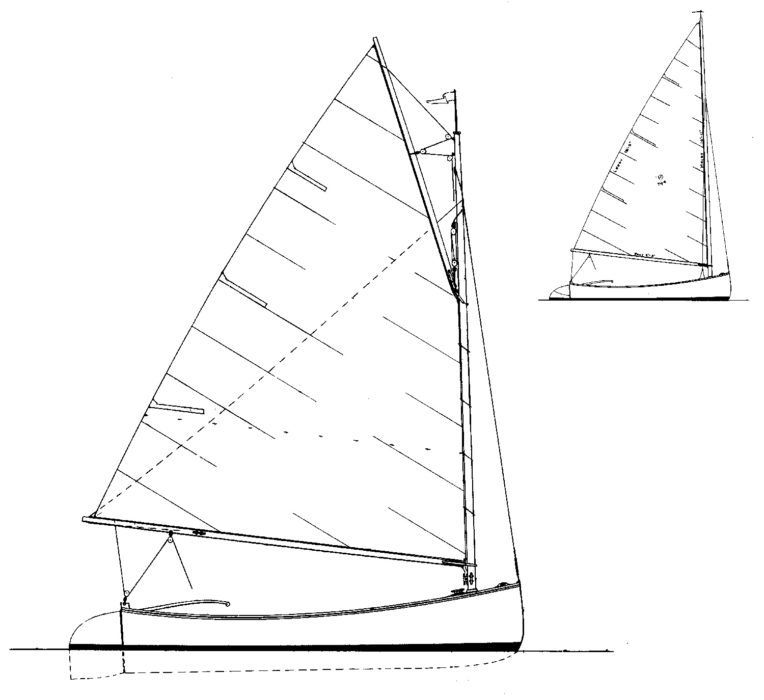
Wittholz Dinghy Particulars: LOA 11′, Beam 5′, Draft (cb up) 8″, Draft (cb down) 2’11”, Weight 150 lbs, Sail area 80 sq ft
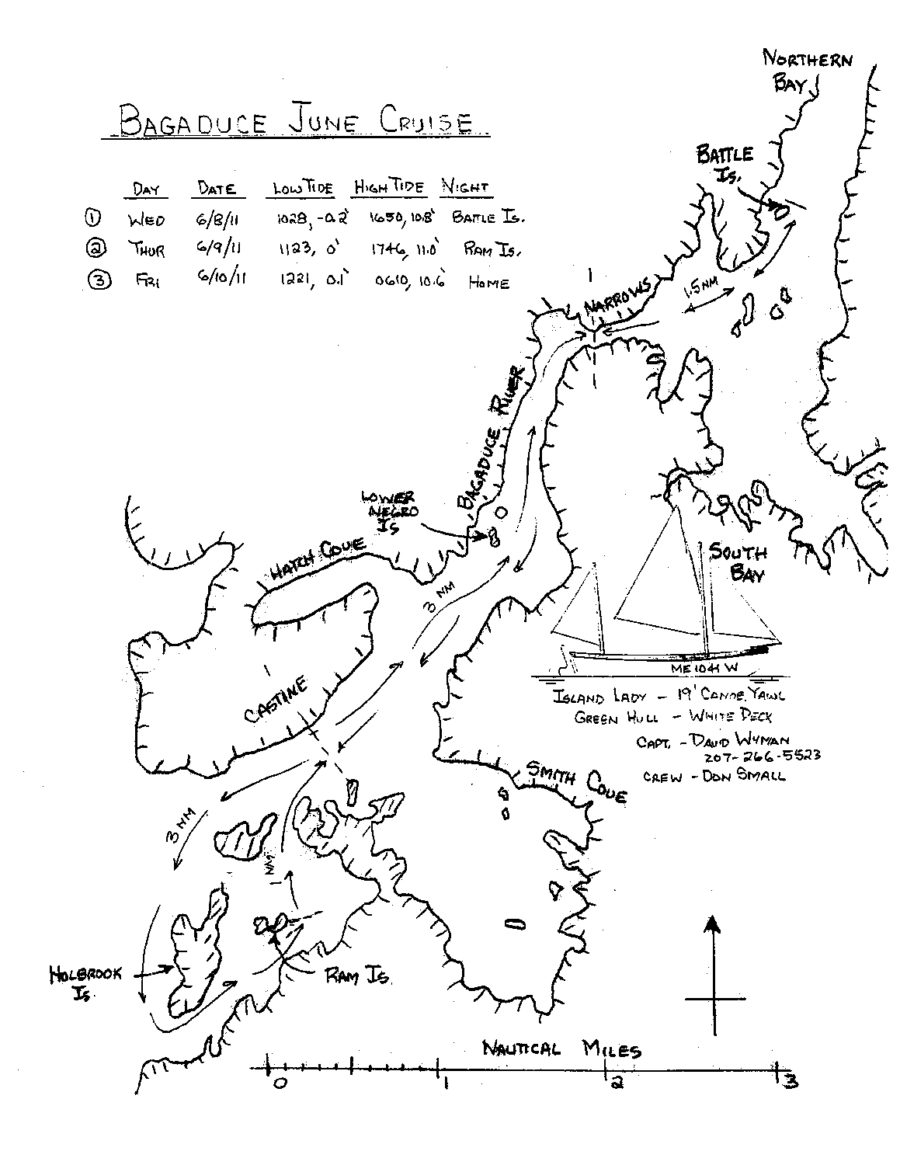
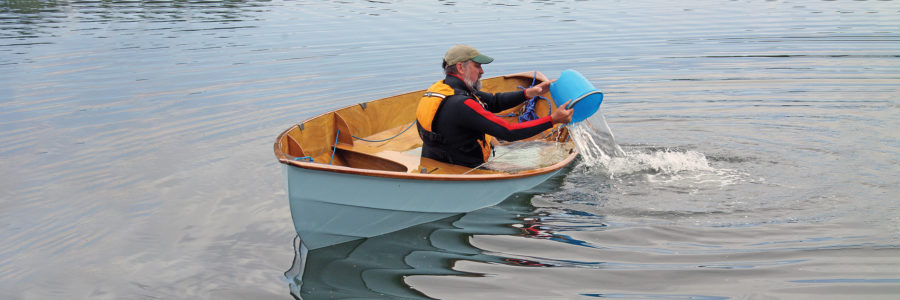

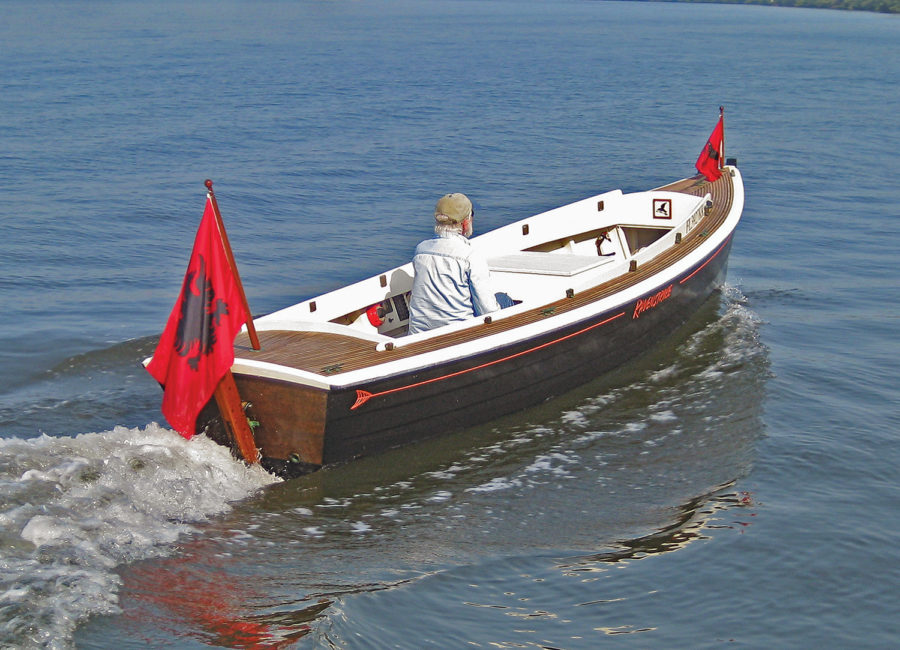
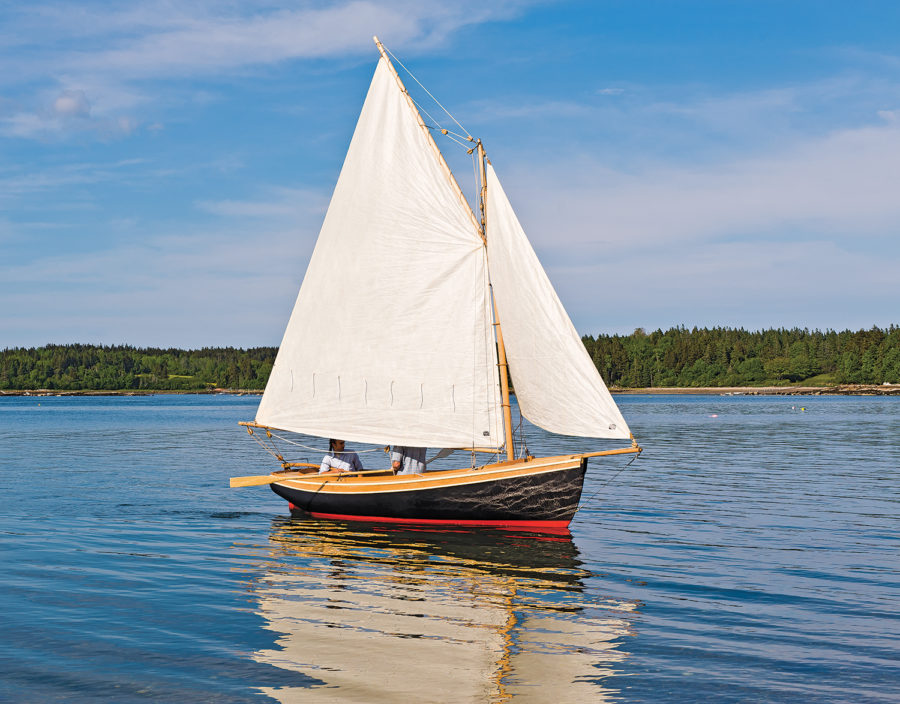
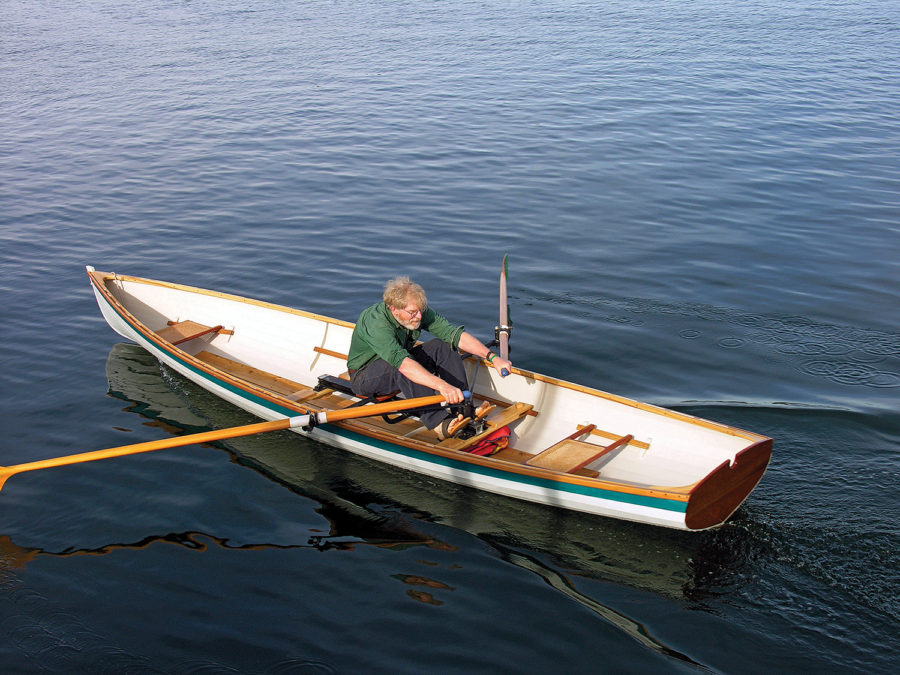
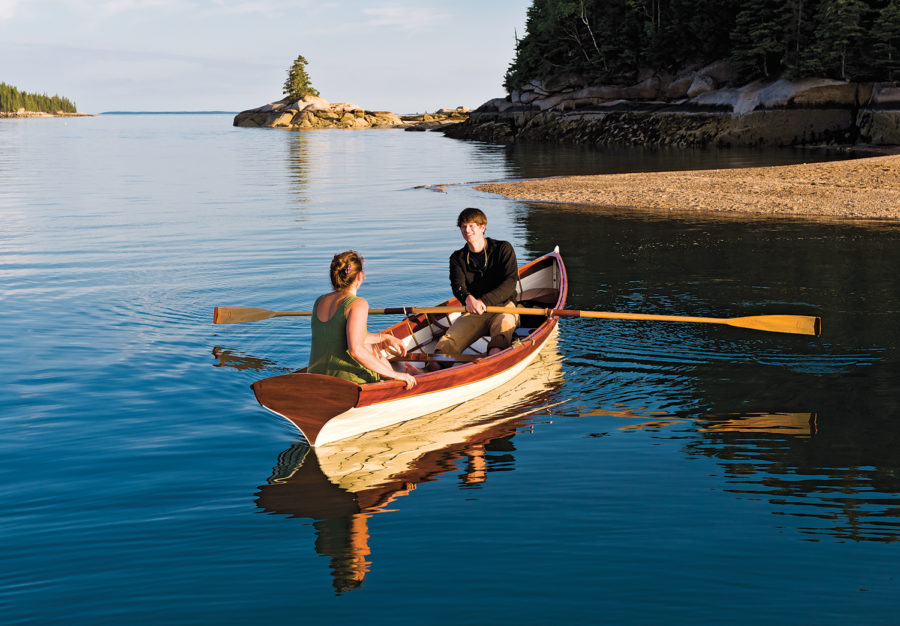
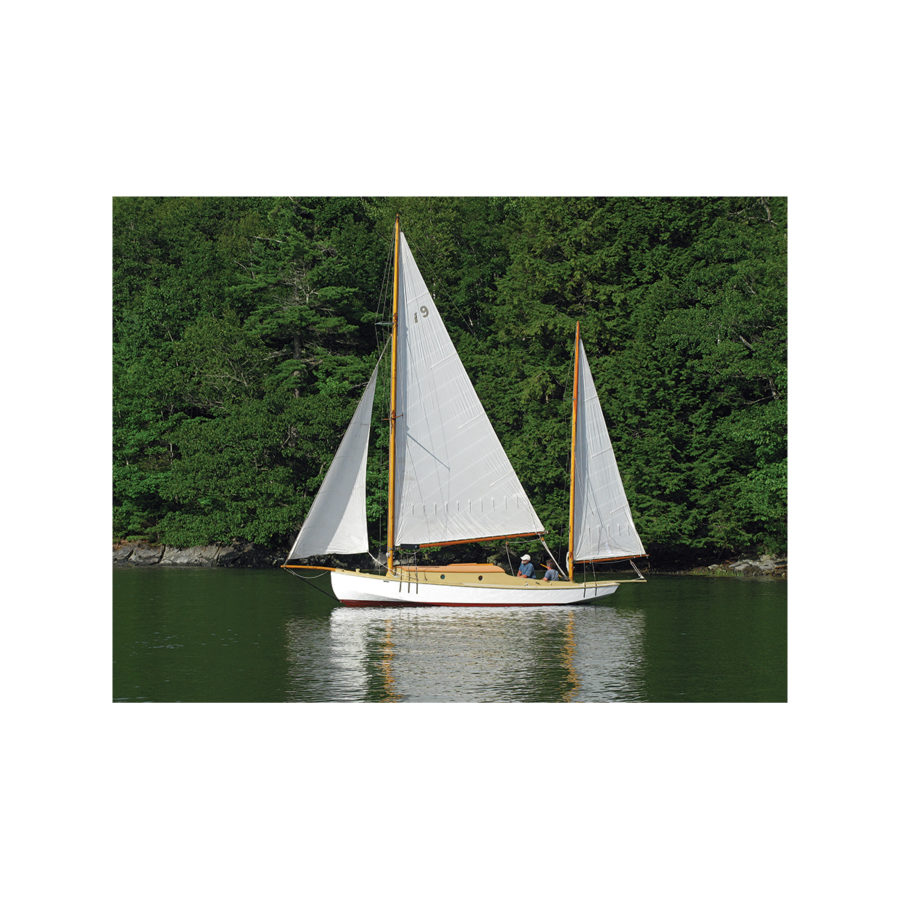
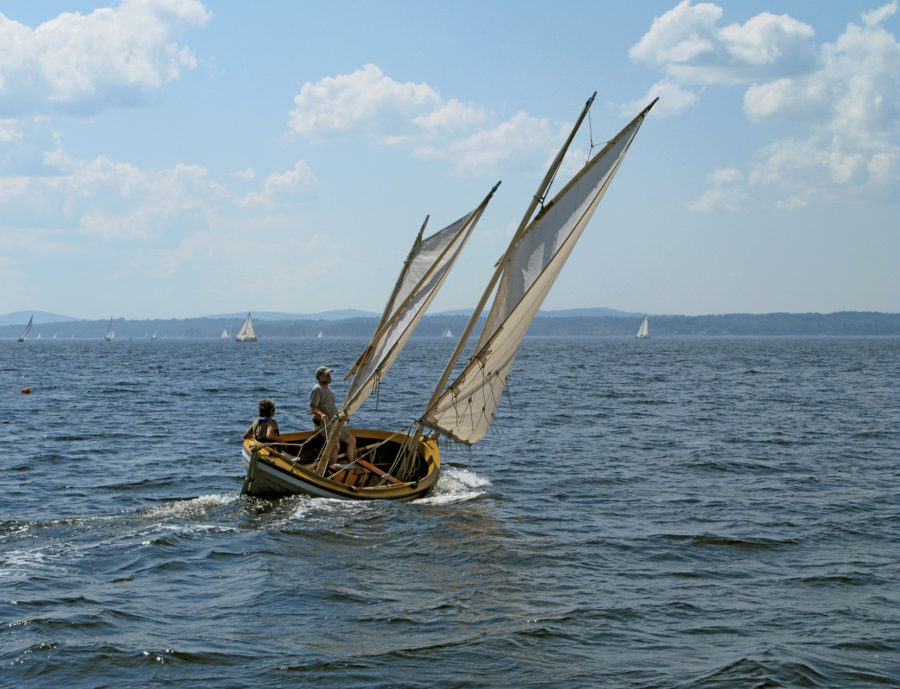
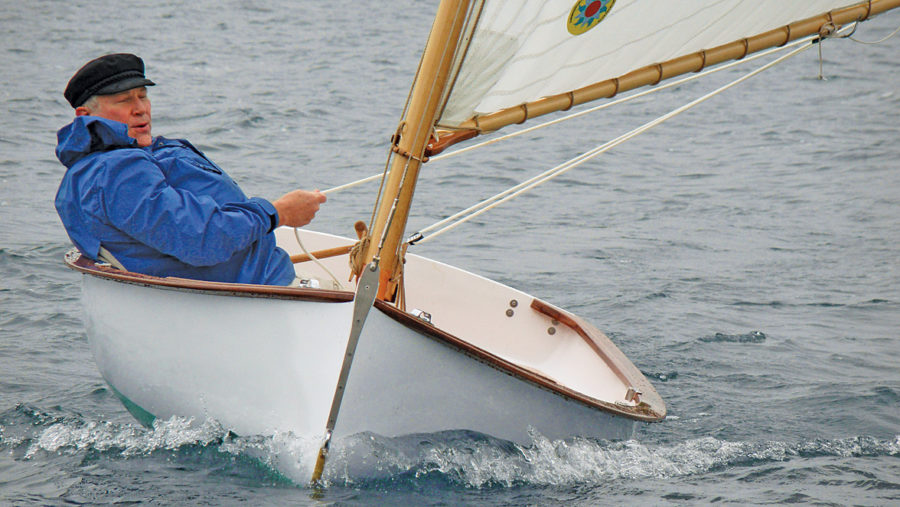
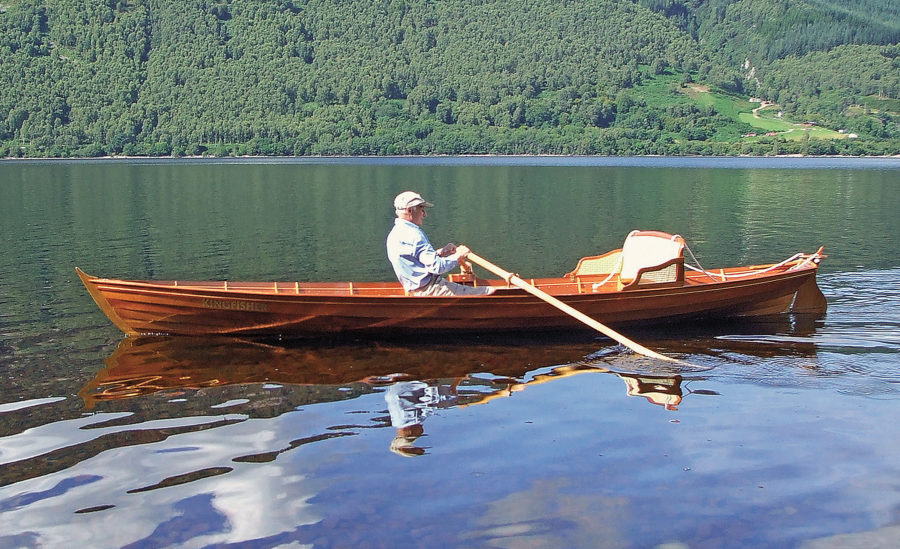
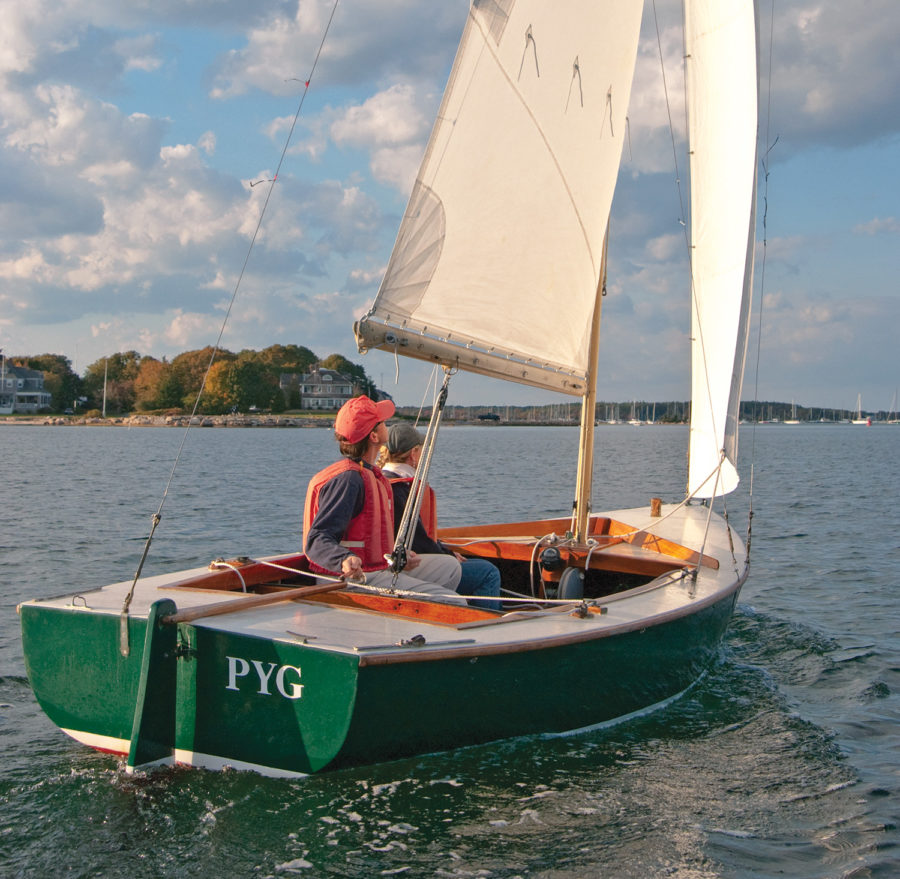
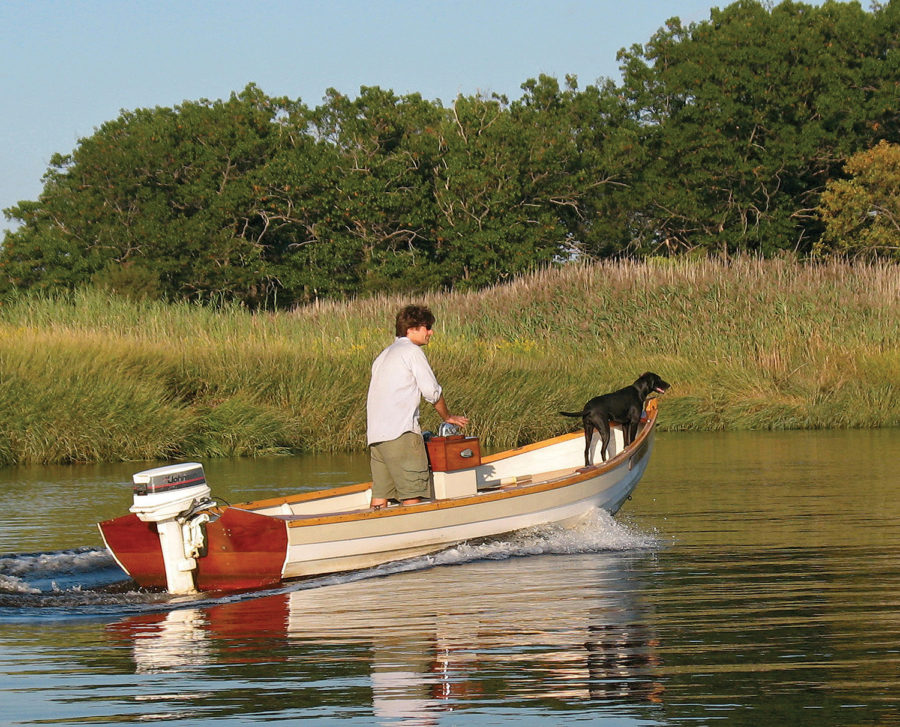
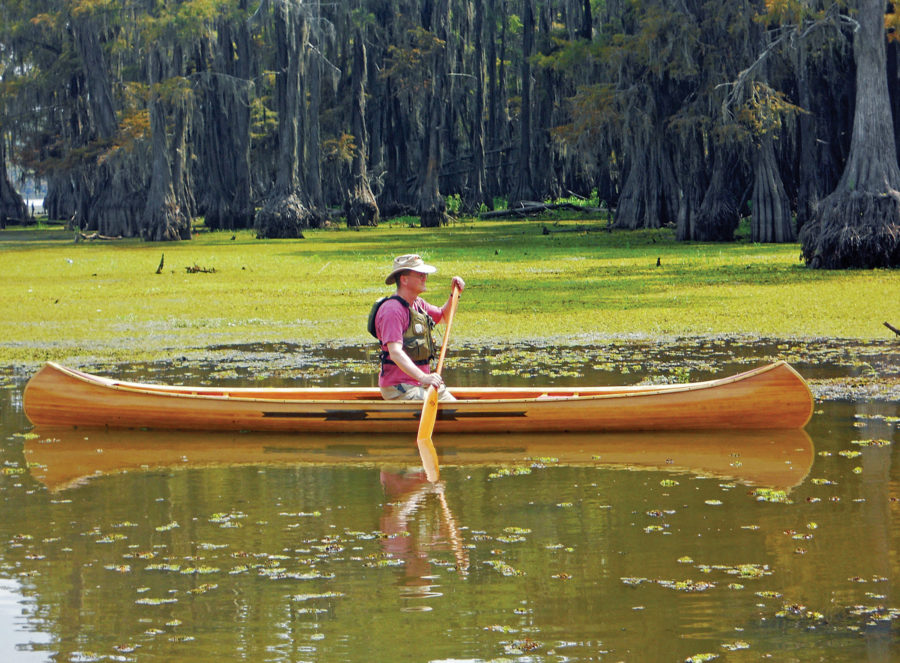
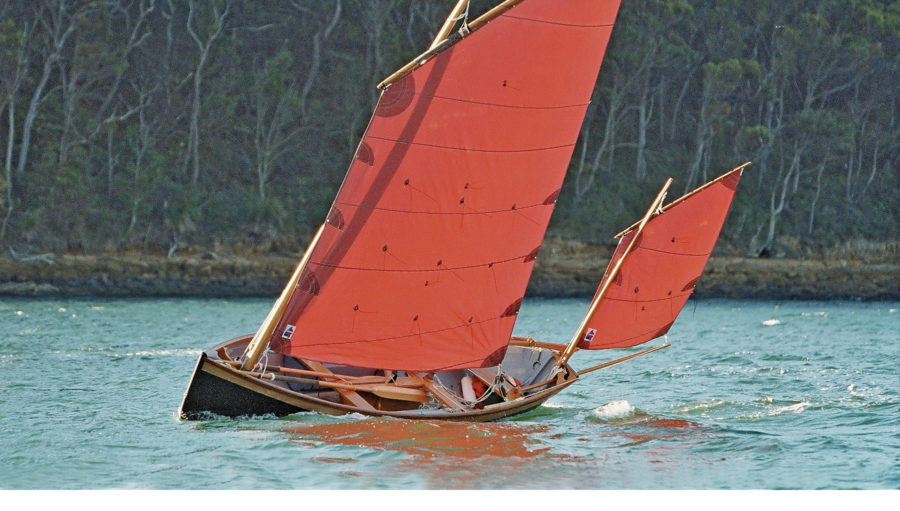
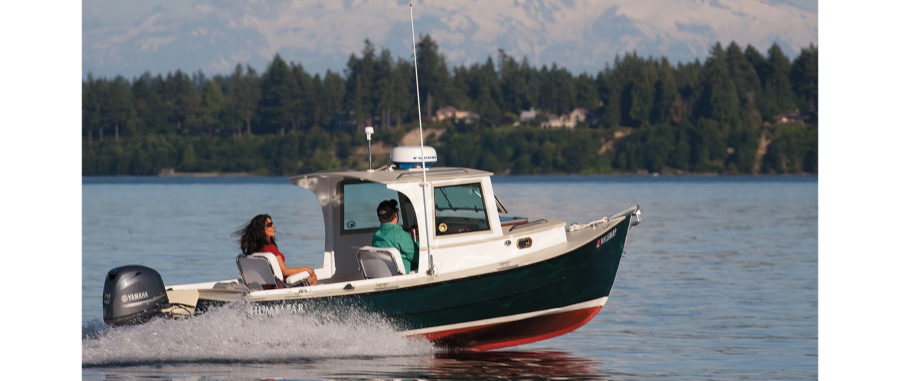
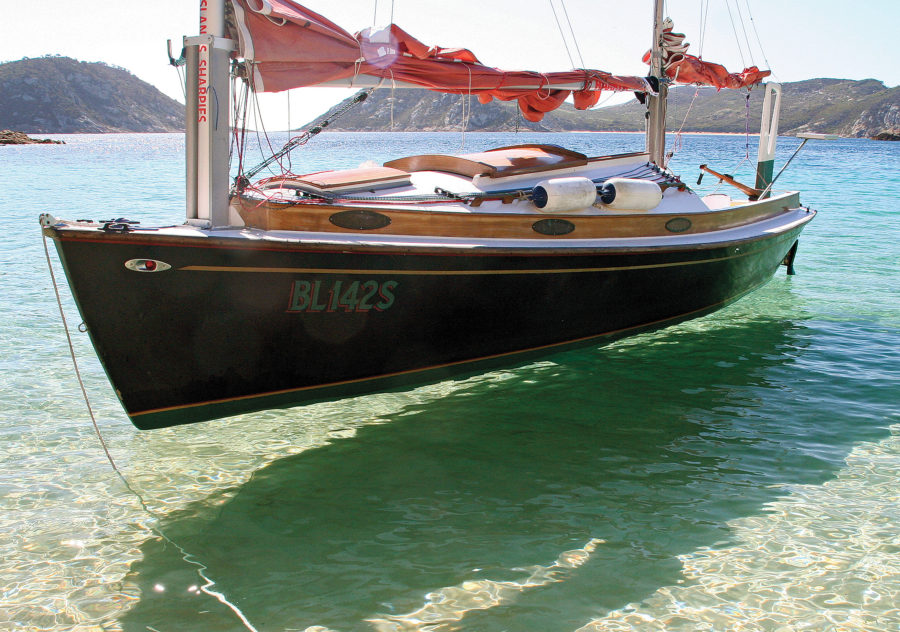
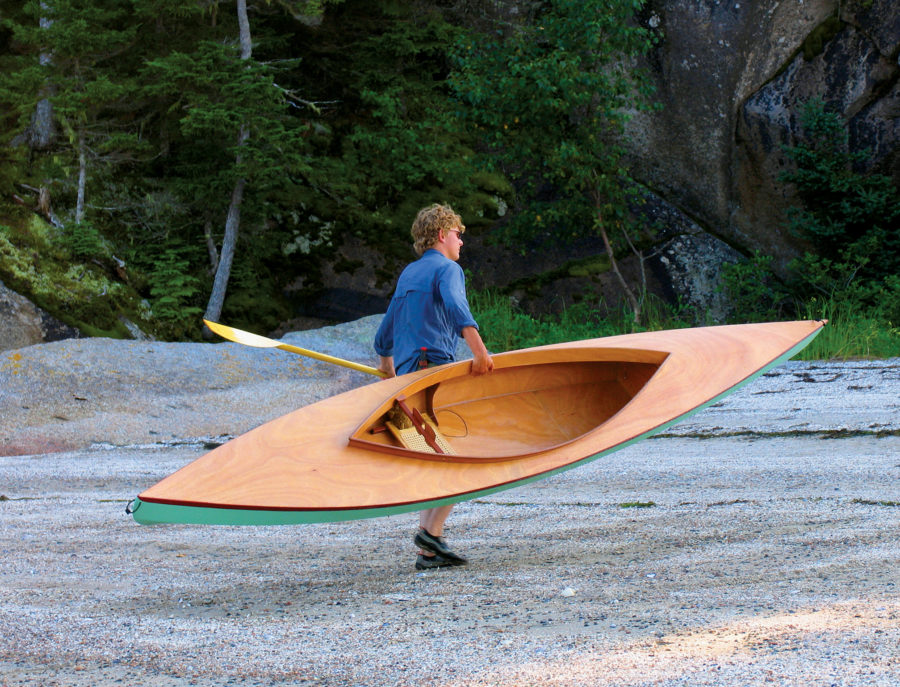
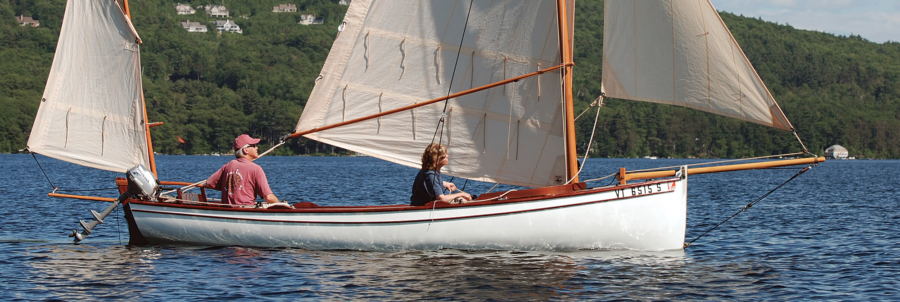
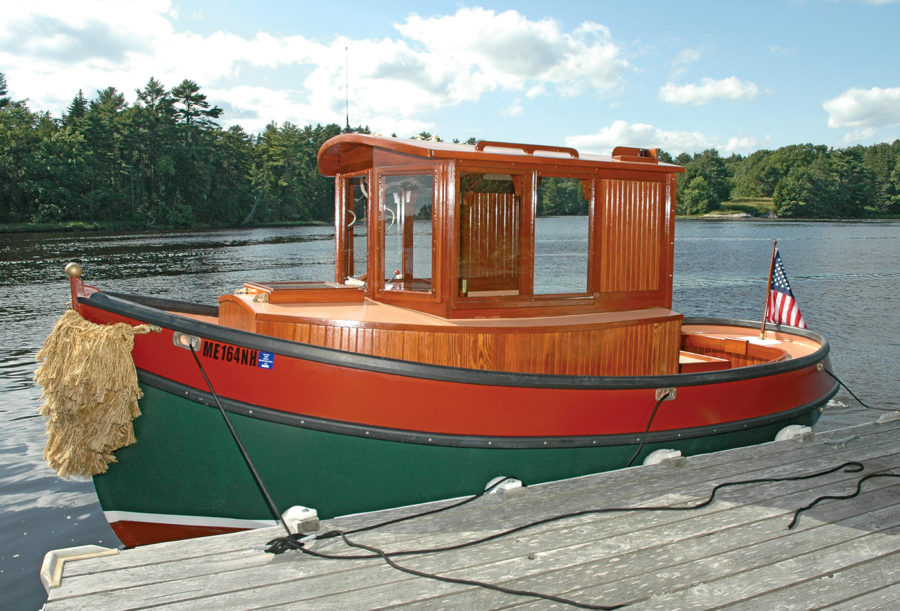
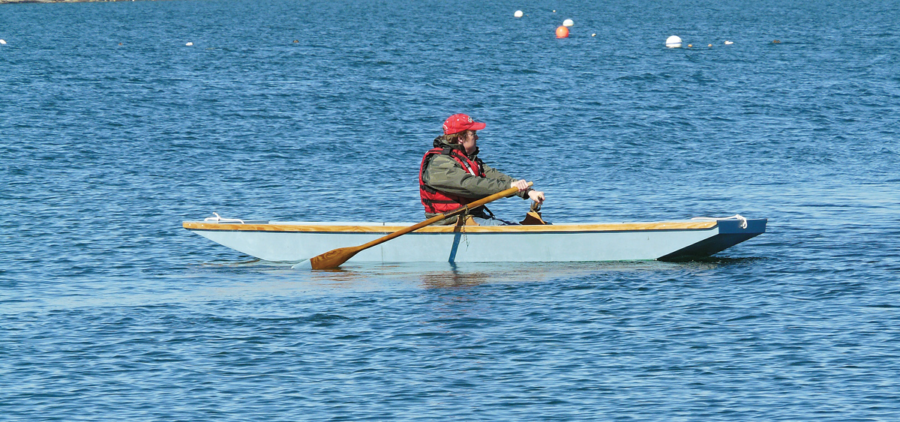
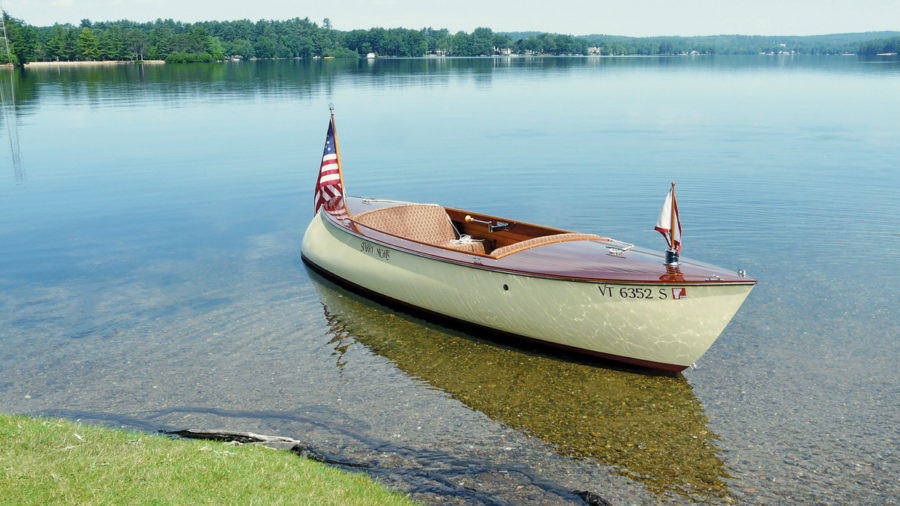
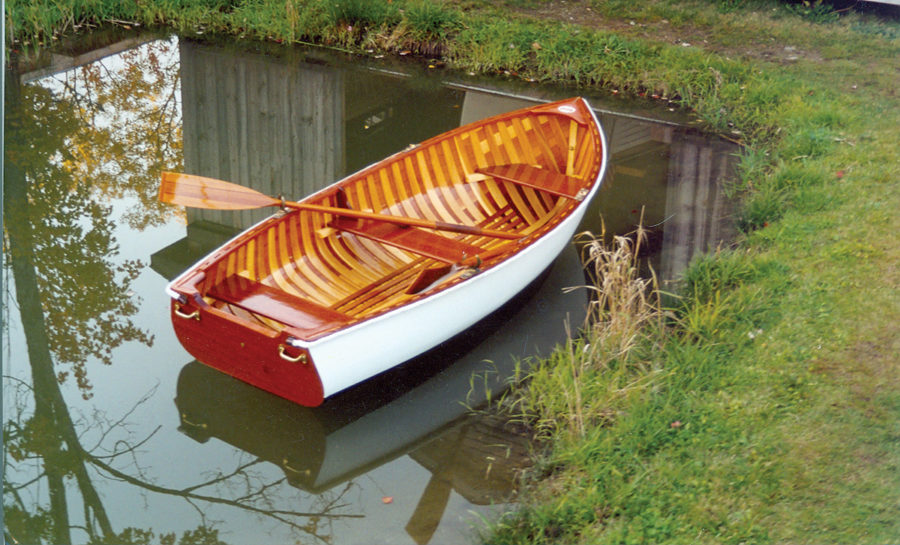
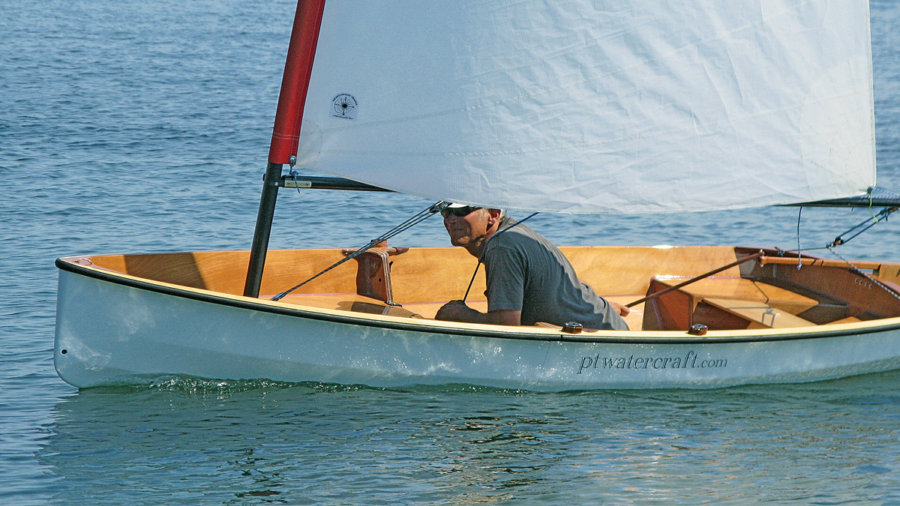
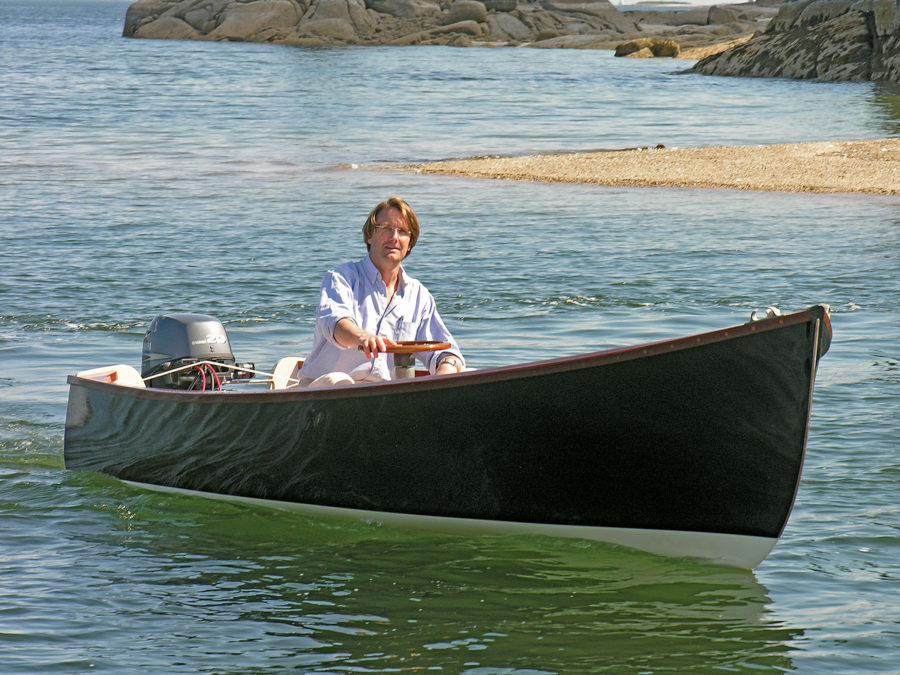
Designed as a pretty displacement boat for heavy loads
– Ply boats that plane sailing upwind need minimum curve in the lines while maintaining stability.
– Raid boats encourage this.
Love the design and I would like to build it. I don’t have facilities or ability to do cold-molding. Would it be possible to built it with strip planking? Since retirement I have successfully built 8 small boats as gifts to family and friends. Great hobby. Eager to receive your reply. Was a charter member of WoodenBoat, now subscribe to Small Boats.
Thanks,
Ron Wood
On the WoodenBoat Forum I see that a couple of builders strip-planked the dinghy. A photograph of a cold-molded versions shows laminates curving sharply from the hull to form the skeg. A different approach would be needed for strip-planking.
A friend and I built this boat from Douglas-fir peeler veneer. We bought the veneer from the plywood mill down the road from my house and they sold us a pickup load for something like $80. (In 1993) It ended up slightly heavier, slightly thinner and bomber strong. In addition to the hull, all keel and knees were laminated from those veneers. We had so much veneer that I’m surprised we didn’t make the sail from it! We did go up to Puget Sound to buy some spruce for the spars and I had a fantastic time making those. All in all, it was a very do-able project. Don’t be put off by cold molding. Just read, get setup correctly, and do a little practicing before you start on the boat if you are unsure. (We went directly to work on the boat and it went fine, though we did experience something of a learning curve along the way.) Our target was “an excellent boat, but not magazine quality” and I think we achieved that. We still have it and trade it back and forth every few years. A good boat which we are both still proud of all these years later.
I built these boats in glass from a cold-molded boat I built from plans. I am retired now. Thank for sharing your pictures. Your boats are ❤️.
Richard Wilcoxen
I love that boat. I am from the UK originally where on the Solent they have Yarmouth Scows (ours was a Bembridge Scow) designed by an American, I think. I learnt to sail back in the day when they were all clinker mahogany, ours still with a cotton sail and a steel center plate.
They were virtually uncapsizable but probably 200lb.
The sound of the ripple as they sailed was amazing. I am looking for a retirement project but realize I may not have the skill for the cold molding so I’m going to have to look for a professional to make that crucial part.
Thanks.